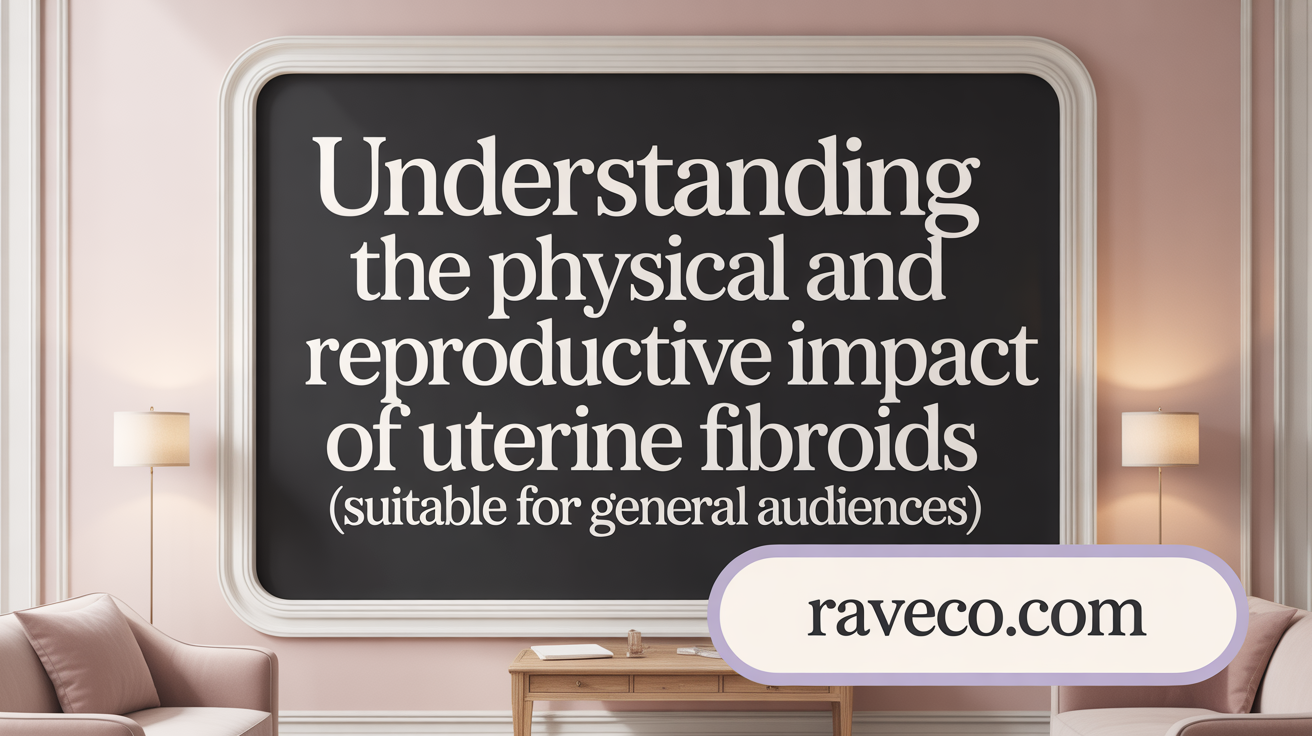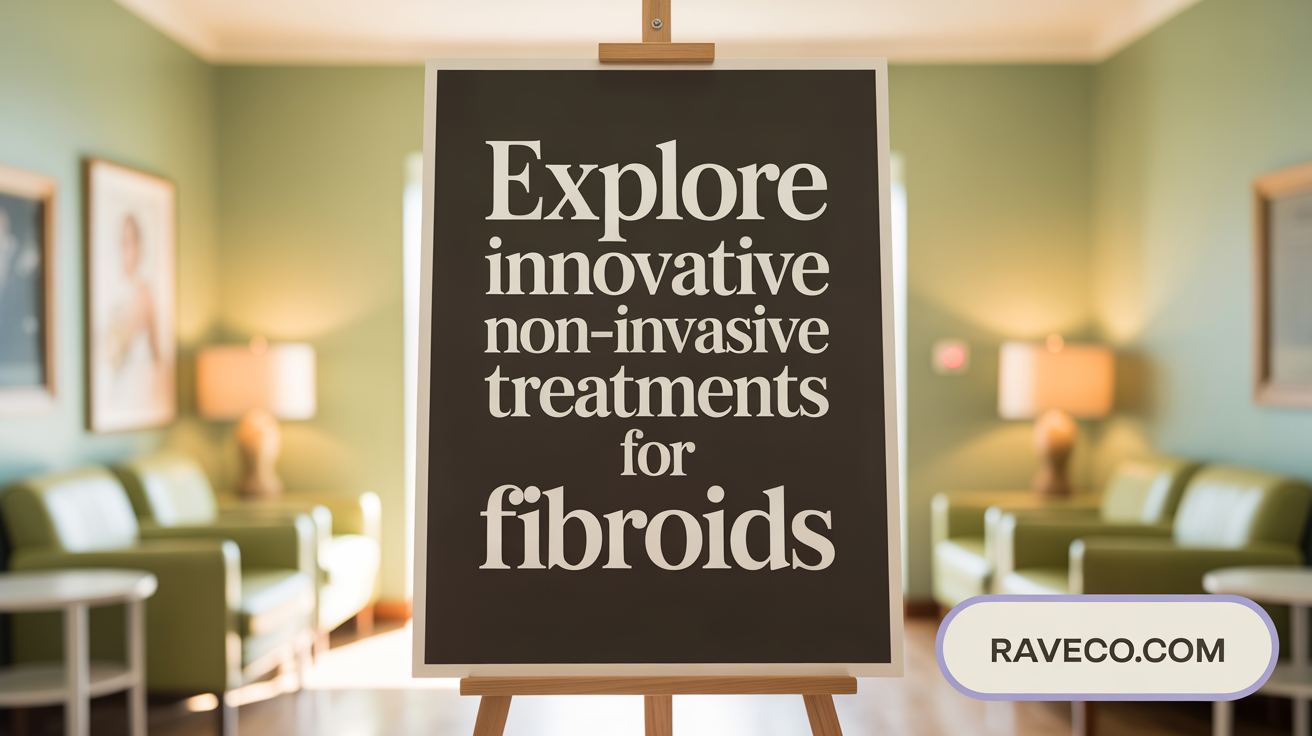Recognizing the Right Time to Address Female Infertility: Key Indicators and Expert Care in Queens

Understanding Uterine Fibroids: The First Step in Treatment
Uterine fibroids are common, benign tumors that affect a large number of women, especially those aged 30 to 50. While some fibroids cause no symptoms and require minimal intervention, others can lead to significant discomfort and complications. This guide will walk you through the nature of fibroids, how they are diagnosed, and the available treatment options, helping you make informed decisions about managing your health.
What Are Uterine Fibroids and Their Impact?

What are uterine fibroids and what symptoms do they cause?
Uterine fibroids are noncancerous growths that develop from the muscle tissue of the uterus. They are extremely common, especially in women aged 30 to 50, with the NIH estimating that up to 80% of women may develop fibroids by age 50. These tumors vary in size, from as small as a seed to larger than a watermelon, and their number can range from one to several.
Fibroids are classified based on their location within the uterus: intramural (within the uterine wall), submucosal (beneath the uterine lining), and subserosal (on the outer surface). Some fibroids, called pedunculated, are attached to the uterus by a stalk. Their size, number, and location influence whether symptoms occur and what treatment might be necessary.
Most fibroids are asymptomatic, meaning women may not notice any issues. However, when symptoms appear, they often include heavy or prolonged menstrual bleeding, pain during periods, pelvic or abdominal pressure, and increased urination due to pressure on the bladder. They can also cause reproductive problems such as difficulty conceiving, miscarriage, or complications during pregnancy.
Diagnosis generally involves pelvic examinations and imaging techniques like ultrasound or MRI. Since symptoms and fibroid characteristics vary, treatment plans are personalized, ranging from watchful waiting and medical therapies to minimally invasive procedures and surgery such as myomectomy or hysterectomy.
Types and sizes of fibroids
Fibroids' sizes can range from tiny seeds to large tumors that fill the pelvic cavity. Their locations include:
| Type | Description | Typical Size Range | Impact on Symptoms |
|---|---|---|---|
| Intramural | Within the uterine wall | Varies; can be small or large | Often causes heavy bleeding and pressure |
| Submucosal | Beneath the uterine lining | Usually smaller, but can cause significant bleeding | Bleeding and reproductive issues |
| Subserosal | On the outer surface of the uterus | Can grow large | Pressure and pain |
| Pedunculated | Attached by a stalk, can be inside or outside the uterus | Variable | Can cause pain and pressure |
Symptoms caused by fibroids
While many women experience no symptoms, those with larger or numerous fibroids may face:
- Heavy menstrual bleeding
- Menstrual cramps
- Pelvic pressure or fullness
- Pain during sex
- Frequent urination or urinary retention
- Constipation
- Lower abdominal swelling or bulging
Potential reproductive issues linked to fibroids
Fibroids can interfere with conception and pregnancy. They may block embryo implantation or cause the uterus to be less accommodating for pregnancy, leading to infertility or miscarriages. During pregnancy, fibroids may grow faster, increasing risks for complications like preterm labor, placental abruption, and Cesarean sections.
Understanding the nature of fibroids and their effects helps in choosing appropriate management strategies, tailored to individual health needs and reproductive goals.
Diagnosing Fibroids: How Healthcare Professionals Identify the Condition

How are uterine fibroids diagnosed by healthcare professionals?
Uterine fibroids are often detected through a combination of physical pelvic examinations and advanced imaging tests. During a pelvic exam, a healthcare provider can feel the shape and size of the uterus, checking for irregularities or lumps that might indicate fibroids.
Ultrasound is the most common and effective imaging tool used. There are two main types:
- Transabdominal ultrasound: The probe is moved over the abdomen, providing a broad view of the uterus.
- Transvaginal ultrasound: A probe is inserted into the vagina for a closer, more detailed image of the uterine walls and fibroids.
If ultrasound results are unclear or more detailed information is needed, additional imaging methods can be used. Magnetic Resonance Imaging (MRI) offers high-resolution images, helping to determine the exact size and location of fibroids. Other procedures like hysteroscopy allow direct visualization inside the uterus, especially helpful for submucosal fibroids.
Accurate diagnosis is crucial for planning appropriate treatments. Correctly identifying the type, size, and position of fibroids influences treatment options, ranging from medication to surgical removal.
Why is precise diagnosis important?
A proper diagnosis ensures that healthcare providers select the most suitable treatment approach. It helps to distinguish fibroids from other uterine issues and assess the potential impact on fertility and pregnancy complications.
Exploring Fibroid Removal: Surgical Treatment Options

What treatment options are available for removing or managing uterine fibroids?
Uterine fibroids, noncancerous growths in or on the uterus, can be managed through a variety of medical, minimally invasive, and surgical treatments. The choice depends on the size, number, location of the fibroids, and the woman's desire for future fertility.
Surgical procedures aim to remove fibroids while preserving the uterus in many cases. For instance, myomectomy is a common operation that can be performed in different ways, depending on the patient's needs.
Myomectomy types: hysteroscopic, laparoscopic, laparotomy, robotic-assisted
- Hysteroscopic Myomectomy: Done through the vagina, using a hysteroscope to remove fibroids from within the uterine cavity. It's suitable for smaller, submucosal fibroids and usually allows quick recovery.
- Laparoscopic Myomectomy: This minimally invasive option involves small abdominal incisions with the aid of a camera and specialized instruments. It is effective for multiple or larger fibroids and offers a shorter recovery period.
- Laparotomy: An open surgical approach involving a larger abdominal incision, typically used for very large or multiple fibroids when minimally invasive options are unsuitable.
- Robotic-assisted Myomectomy: This technique uses robotic systems to enhance precision through small incisions, often resulting in less pain, faster recovery, and better visualization.
Most myomectomies enable women to retain their uterus, which is beneficial for those wishing to have children.
Indications for hysterectomy
Hysterectomy involves removing the entire uterus and is considered a definitive solution for fibroids that cause severe symptoms or are not suitable for other procedures. It may be recommended when fibroids are very large, numerous, or resistant to less invasive treatments. Women who have completed their family planning often opt for hysterectomy as it effectively eliminates fibroid-related issues.
This procedure can be performed via traditional open surgery, minimally invasive laparoscopic or robotic methods, or vaginally. Recovery typically ranges from two to six weeks, depending on the surgical approach.
Recovery and fertility considerations
Recovery times vary based on the procedure type. Minimally invasive surgeries like hysteroscopic and laparoscopic myomectomies generally allow women to return to normal activities within a couple of weeks. In contrast, open surgeries like laparotomy require a longer healing period.
Fertility preservation is a major factor influencing treatment choice. Myomectomy is often preferred for women wishing to conceive, as it removes fibroids without damaging the uterus. Conversely, hysterectomy, while eliminating fibroid symptoms effectively, naturally ends fertility.
Women should discuss their reproductive plans with their healthcare provider to select the most suitable intervention.
| Treatment Method | Typical Recovery Time | Impact on Fertility | Suitable For |
|---|---|---|---|
| Hysteroscopic Myomectomy | 1-3 days | Preserves fertility | Small, submucosal fibroids |
| Laparoscopic Myomectomy | 1-2 weeks | Preserves fertility | Larger or multiple fibroids |
| Robotic-assisted Myomectomy | 1-2 weeks | Preserves fertility | Large, complex fibroids |
| Laparotomy (Open Surgery) | 4-6 weeks | Preserves fertility (if ovaries intact) | Large or multiple fibroids |
| Hysterectomy | 2-6 weeks | Not fertility-preserving | Severe symptoms, extensive fibroids |
Understanding the nuances of each treatment helps women and their healthcare team to plan the best approach, balancing symptom relief and reproductive goals.
Non-Surgical Fibroid Treatments: Innovative Approaches Beyond Surgery
 In recent years, there has been significant progress in developing non-surgical options for managing uterine fibroids. These approaches often provide effective symptom relief while avoiding the risks and recovery time associated with traditional surgery.
In recent years, there has been significant progress in developing non-surgical options for managing uterine fibroids. These approaches often provide effective symptom relief while avoiding the risks and recovery time associated with traditional surgery.
One prominent minimally invasive procedure is uterine artery embolization (UAE). During this outpatient process, tiny particles are injected into blood vessels supplying the fibroids, which blocks their blood flow and causes the fibroids to shrink. UAE is especially suitable for women who have completed childbearing.
MRI-guided focused ultrasound (FUS) is another breakthrough. This technique uses high-frequency sound waves precisely targeted at fibroids, heating and destroying the tissue without any incisions. FUS is a noninvasive option that offers symptom improvement with minimal downtime, although data on long-term pregnancy outcomes are still being collected.
Additionally, laparoscopic radiofrequency ablation strategies like the Sonata® Treatment utilize heat generated by radio waves to shrink fibroids. This modern technique involves inserting a device through small incisions or hysteroscopic approaches to deliver energy directly into fibroid tissue, effectively reducing their size.
On the medication front, several FDA-approved drugs help manage fibroid symptoms. Medications such as Oriahnn® and Myfembree® combine hormonal agents to help control bleeding and reduce fibroid size. They are often used for temporary relief or in cases where surgery is not immediately necessary.
Overall, these innovative, minimally invasive treatments are expanding options for women seeking relief from fibroid symptoms without undergoing major surgery. New advancements continue to improve safety profiles, efficacy, and preservation of fertility.
| Treatment Method | Approach | Suitable For | Additional Notes |
|---|---|---|---|
| Uterine Artery Embolization | Blood vessel blockage via tiny particles | Women post-childbearing | Outpatient, risks include pregnancy complications |
| MRI-guided Focused Ultrasound | Focused ultrasound waves to destroy fibroids | Women post-childbearing | Noninvasive, requires MRI |
| Radiofrequency Ablation (Sonata®) | Heat via radio waves inserted into fibroids | Suitable for certain fibroids | Minimally invasive, small incisions possible |
| FDA-Approved Medications | Hormonal therapies (Oriahnn®, Myfembree®) | Symptom management | Temporary relief, may not reduce size permanently |
By offering multiple options, healthcare providers now tailor treatments to individual patient needs, focusing on efficacy, safety, and future fertility considerations.
Medical Management and Diet: Supporting Fibroid Symptom Relief
Can fibroids be shrunk through dietary changes or medications?
Fibroids are benign tumors that can affect many aspects of a woman's health, including menstrual bleeding, pelvic pain, and reproductive outcomes. While medications and diet modifications are useful for managing symptoms, they do not provide a permanent cure or guarantee shrinkage of fibroids.
Hormonal medications, such as gonadotropin-releasing hormone (GnRH) analogs and hormonal contraceptives, can temporarily reduce the size of fibroids by suppressing estrogen and progesterone, hormones that influence fibroid growth. These medications are often prescribed before surgery or to control symptoms temporarily, but they do not eliminate fibroids entirely.
Pain management options like NSAIDs (nonsteroidal anti-inflammatory drugs) help alleviate discomfort but do not influence fibroid size.
Dietary choices can support overall health and may play a role in managing fibroid symptoms. Consuming a diet rich in high-fiber vegetables, fruits, whole grains, and omega-3 fatty acids can help balance hormones and reduce inflammation. Limiting processed meats, high-fat dairy, alcohol, caffeine, and refined sugars might prevent further fibroid growth.
Supplements such as vitamin D, fish oil, and herbal products like green tea or cinnamon are believed to have anti-inflammatory or estrogen-modulating effects, which could contribute to shrinking fibroids or easing symptoms.
However, it is important to understand that diet alone cannot guarantee fibroids will shrink or prevent new ones from forming. A comprehensive approach includes medical supervision, maintaining a healthy weight, and lifestyle modifications.
In summary, while dietary and medical interventions can support symptom relief and potentially influence fibroid size to some extent, they do not serve as definitive treatments. Combining lifestyle strategies with medical management under healthcare guidance offers the best approach to dealing with fibroids.
Understanding Risks and Benefits: What to Expect From Treatment Options
When considering treatment options for uterine fibroids, it's important to weigh the potential benefits against the associated risks. Surgical procedures like myomectomy and hysterectomy are often effective in providing symptom relief. Hysterectomy, which involves removing the entire uterus, offers a definitive cure and eliminates future fibroid growth. This is especially beneficial for women who not wish to preserve fertility. However, surgery carries risks such as bleeding, infection, injury to surrounding organs, and adhesions forming afterwards. There are also considerations regarding recovery time, which can range from a few days to several weeks.
Myomectomy, which removes fibroids while preserving the uterus, allows women to maintain fertility. Depending on the fibroid’s size and location, it can be performed hysteroscopically, laparoscopically, or through open surgery. While it generally results in less recovery time and preserves reproductive potential, it still shares surgical risks like bleeding and organ injury. Additionally, fibroids can sometimes recur after myomectomy.
Non-surgical options such as uterine artery embolization (UAE) and MRI-guided ultrasound are less invasive, often involving shorter recovery periods. UAE blocks blood flow to fibroids, causing them to shrink, with a typical recovery of a few days. However, these procedures may carry risks like post-embolization pain, bleeding, infection, or rare complications affecting the ovaries or uterus. Their long-term effectiveness can vary, and some women may require additional treatment.
Medical management with hormonal therapies, such as birth control pills, GnRH agonists, or ulipristal acetate, can provide symptom relief, reduce fibroid size, and are generally safe when used appropriately. These medications often have fewer immediate risks but are usually temporary solutions and can have side effects like menopause-like symptoms, osteoporosis, or liver issues.
In summary, each treatment approach has its own spectrum of benefits and risks. Surgery offers more definitive relief but involves higher immediate risks and longer recovery. Non-surgical and medical treatments may be safer and less invasive but might not provide permanent solutions. Patients should discuss their individual health status, fibroid characteristics, and reproductive goals with their healthcare team to choose the most suitable strategy.
When Should Treatment Be Considered? Size, Symptoms, and Urgency
The decision to treat uterine fibroids depends on multiple factors, including their size, symptom severity, and potential for complications.
Fibroid size alone is not a strict marker of danger. While larger fibroids—typically those exceeding 8 to 10 centimeters—may more frequently require intervention, the primary consideration is how much they affect the patient's health and quality of life. Very large fibroids can cause significant discomfort, pressure on adjacent organs, or interfere with fertility. In some cases, fibroids that grow rapidly or become extremely large, filling the abdominal cavity, might lead to complications such as uterine distortion or severe pain.
Symptom severity plays a crucial role in guiding treatment timing. Women experiencing heavy menstrual bleeding, intense pelvic pain, pressure on the bladder or rectum, or pain during sex are more likely to benefit from intervention. Even smaller fibroids can cause debilitating symptoms that diminish quality of life, warranting medical or surgical management.
Furthermore, large or multiple fibroids increase the risk of complications such as anemia from excessive bleeding or interference with pregnancy. Medical professionals recommend an individualized assessment that considers all these factors. A tailored approach ensures that treatment aligns with the specific health condition, symptoms, and future reproductive plans of each woman.
In summary, while size can be an indicator of potential issues, the dominant factor in deciding treatment is how fibroids affect the patient, with larger size complemented by symptom severity and risk of complications prompting more urgent management.
Choosing the Best Treatment: Factors for Women to Consider

What should women consider when choosing a fibroid treatment method?
When women are evaluating treatment options for uterine fibroids, a variety of factors need to be considered to determine the most suitable approach. Firstly, the severity of symptoms such as heavy menstrual bleeding, pelvic pain, or pressure effects on nearby organs impacts treatment choice. For example, small, asymptomatic fibroids may only require medical monitoring, while larger or symptomatic ones might need surgical intervention.
The location, size, and number of fibroids are crucial in planning treatment. Submucosal fibroids impacting the uterine lining may be best addressed via hysteroscopic procedures, whereas larger, intramural fibroids could require myomectomy or other surgical methods.
Fertility goals also play a significant role. Women wishing to preserve their fertility may prefer conservative options like myomectomy or minimally invasive procedures such as uterine artery embolization or radiofrequency ablation. Conversely, women who do not plan future pregnancies might opt for hysterectomy for definitive relief.
Personal preferences and lifestyle considerations are equally important. Some women may prioritize shorter recovery times, avoiding invasive surgery, or minimizing risks associated with anesthesia. Others might consider the potential side effects, including hormonal changes or risks of future pregnancy complications.
Most importantly, women should collaborate closely with healthcare providers—gynecologists, radiologists, and primary care physicians—to weigh the benefits and risks of each option. This individualized approach ensures that treatment plans align with personal health, family plans, and lifestyle, facilitating an informed and confident choice for managing fibroids.
To aid understanding, here’s a comparison table summarizing various treatment options:
| Treatment Method | Invasiveness | Fertility Preservation | Suitable for Fibroid Size | Common Risks | Recovery Time |
|---|---|---|---|---|---|
| Medications (hormonal) | Non-invasive | Yes | Small to moderate | Side effects, temporary | Days to weeks |
| Myomectomy | Minimally invasive | Yes | All sizes, preserving uterus | Bleeding, organ injury | Few days to weeks |
| Hysterectomy | Surgical | No | All sizes, definitive | Bleeding, surgical risks | Up to 6 weeks |
| Uterine Artery Embolization | Non-invasive | No (for future pregnancy risks) | Most fibroid sizes | Pain, risk of obstetric issues | Short (days) |
| Radiofrequency Ablation (like Sonata®) | Minimally invasive | Yes | Suitable for small to moderate fibroids | Rare complications | Few days |
Understanding these aspects can empower women to select a treatment approach that best fits their health needs, future plans, and lifestyle preferences.
Empowering Women Through Knowledge and Choices
Uterine fibroids are a common condition with a variety of treatment possibilities tailored to each woman's unique needs, symptoms, and life goals. Understanding the nature of fibroids, diagnostic methods, and the full spectrum of treatment options—from medications and minimally invasive procedures to surgical interventions—empowers women to actively participate in their healthcare decisions. Considering risks, benefits, and personal preferences enables informed choices that improve quality of life and preserve fertility when desired. Collaborating closely with healthcare providers ensures a personalized approach that balances clinical efficacy with individual goals, leading to the best possible outcomes.
References
- Uterine Fibroids: What Treatments Are Available - Yale Medicine
- Uterine Fibroids: Causes, Symptoms & Treatment - Cleveland Clinic
- Fibroid Tumors: What Every Woman Must Know - WebMD
- Uterine Fibroids: Four Things Every Woman Should Know
- Treatment Fibroids - NHS
- Learn More – Surgery for fibroids - InformedHealth.org - NCBI
- Uterine Fibroids - FDA
- 10 Uterine Fibroid Facts Every Woman Should Know





.png)